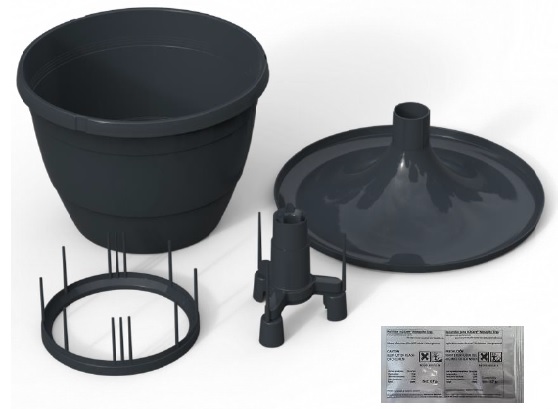MOSQUITO TRAP (In2Care)
Valid Article
MOSQUITO TRAP (In2Care)
Specifications
- Mosquito trap made of durable black polyethylene components. Consists of:
- Lid
- Central tube
- Floater to attach gauze strip
- Click-on interface
- Reservoir
- Sachets containing bioactives lasting for 4-6 weeks/ sachet, containing:
- Gauze strip treated with bioactives, specially designed to facilitate the effective transfer of bioactives onto mosquitoe contacting the strip.
- Bioactives (pyriproxyfen 70- 80% w/w, Beauveria bassiana entomopathogenic fungi 7- 13% w/w, inert ingredients 12- 18% w/w)
- Attractant tablets
- Triple effect
- Reduced survival of female mosquitoes entering the trap
- Larvae present or hatching in the trap die when development reaches the pupal stage
Autodissemination impact as female mosquitoes entering the trap acquire and disperse lethal doses of larvicidal agent during skip-oviposition to further contaminate other breeding sites before dying.
Packaging & Labelling
Packaging containing:
- Components to assemble trap
- Refill sachets containing bioactives (200 units of 0.7 grams)
Instructions for use
The use of the In2Care ® trap should be part of an integrated mosquito control strategy, including measures such as larval source reduction, long-lasting insecticide-treated nets, indoor residual spraying, and other appropriate measures.
- Choose appropriate locations for placing of traps. To identify locations, use input from epidemiological and entomological data in order to pinpoint mosquito breeding areas. Each trap can cover an area of 400 m2 (20 x 20 m).
- If possible, to reduce competition from other breeding sites in the area, remove or make inaccessible other potential breeding spots containing stagnant water (empty tins, old tyres, buckets).
- Assemble trap by following manufacturer's instructions
- Place trap on level area of ground with shade and/or vegetated places
- Fill the central pot with 3 litres of clean water
- Taking care to avoid extensive touching of the gauze, and while wearing gloves, fix gauze onto floater
- Add contents of sachet (powder and attractant tablet) into water
- Place the gauze-carrying floater inside the trap over the central tube onto the water
- Fix the lid of the trap
Considerations for placement
- Trap has to be placed to a shady location. Avoid continuous direct sunlight.
- Trap must be placed on flat ground. The trap itself has to be stable and level.
- Do not place on surfaces that are likely to become submerged.
- Each trap can cover a space of 400 m2. Distance between 2 traps should be greater than 5 meters but less than 40 metres. Ideally traps should be placed every 20 metres.
Trap maintenance
- Re-visit each trap every 6 – 8 weeks.
- Remove the lid and take out the floater. Throw away the old piece of gauze in a garbage container and the remaining water by emptying the trap in a sink.
Refill the trap with 3 litre of clean tap water. Take a new refill sachet and repeat the assembly steps.
Precautions for Use
The toxicity of the bioactives to mammals is extremely low. However, it is stated that the bioactives may cause sensitization by inhalation and skin contact and that they are very toxic to aquatic organisms and may cause long-term adverse effects in the aquatic environment. Therefore, routine safety measures have to be observed when using the In2Care ® trap:
- keep out of reach of children
- do not eat, drink or smoke during use
- avoid direct contact with eyes and skin
- wear protective clothing during handling and application (goggles, clothes covering arms and legs, gloves, FFP2/ N95 particle mask when handling the contents of the sachet)
- keep all components dry during assembly and maintenance of the trap
- do not apply product in locations accessible to domestic animals
The bioactives used with the product can have serious negative effects for the environment. Residues or discarded/ expired product should not be disposed of with regular waste. Contact your technical referent for appropriate disposal procedures.
Storage
- segregate from foods and animal feeds
- keep away from heat
- protect from direct sunlight
- protect from temperatures above 35 °C
Changes in the properties of the product may occur if substance/product is stored above indicated temperature for extended periods of time.
Waste management
For disposal of expired/ damaged sachets of the bioactives, contact your technical referent.
| H317 | May cause an allergic skin reaction |
| H334 | May cause allergy or asthma symptoms or breathing difficulties if inhaled. |
| H400 | Very toxic to aquatic life. |
| H410 | Very toxic to aquatic life with long lasting effects |
| P234 | Keep only in original container. |
| P260 | Do not breathe dust/fume/gas/mist/vapours/spray. |
| P262 | Do not get in eyes, on skin, or on clothing. |
| P273 | Avoid release to the environment |
| P280 | Wear protective gloves/protective clothing/eye protection/face protection |
| P314 | Get medical advice/attention if you feel unwell. |
| P101 | If medical advice is needed, have product container or label at hand. |
| P501 | Dispose of contents/container to location in accordance with local and regional/ national/ international regulations |

